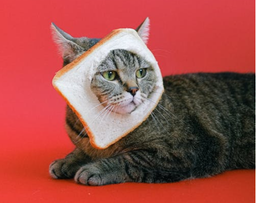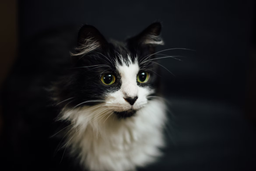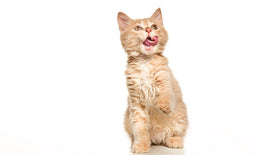Cat food allergies and what to do about them
Skin irritations, digestive problems, and general lethargy could be signs that a cat is eating something that disagrees with them.
Cats’ digestive systems are relatively simple, but the diet may not be doing the best job of keeping them healthy and full of beans.
Cats are carnivores and need animal protein and fat to get the nutrients required for a long and healthy life. Many cats react badly to certain ingredients in commercial cat food, though—leading both them and you to lose hair over what the cause could be.
Untamed takes a look at the most common cat food allergies and gives you the best advice on how to avoid allergic reactions!

Good for us doesn’t necessarily equal good for a cat
Source: Craig Adderley
What are food allergies in cats?
The most common allergic reactions your cat can experience are:
- Insect bite allergies
- Reactions to something in the air
- Food allergies
Insect bites can be spotted, and inhaled allergens will cause easy-to-recognise sneezing, coughing, or wheezing—food allergies are more difficult to pin down.
This makes them harder to treat.
Food allergies in cats occur when your feline’s body mistakes something in the food for a harmful substance. As a result, your cat’s body mounts an immune response in an attempt to get rid of the invader.
The symptoms of food allergies in cats are usually:
- Skin lesions or inflammation
- Gastrointestinal problems
Skin lesions or inflammation
The first sign that your kitty is reacting badly to something eaten will often be an outbreak of skin irritation.
You may not spot the irritation itself, but you will almost certainly notice that your feline is licking or grooming more intensively than usual in a particular area of the body. The irritation is often around the head or neck, so you may see felines scratching themselves incessantly or attempting to lick the affected patch of skin.
The skin irritation will most probably not occur overnight but could develop slowly over a period of days or even weeks.
This is as a result of your kitty’s body gradually starting an immune defence against whatever is causing the allergic reaction.
If it is left untreated, the skin irritation can lead to your kitty’s coat being licked away, raw skin patches, or even open wounds where the scratching or licking has been so intense that the skin has broken.
Gastrointestinal problems
In a few cases—about ten to 15% of allergic reactions—your cat may develop gastrointestinal problems, such as:
Such cases are more serious than skin problems, as vomiting and diarrhoea can lead to:
- Dehydration
- Weight loss
- Knock-on effects on other organs in the body
What causes cat food allergies?

Stay strong and resist the temptation to indulge them
Source: Dids
In mistaking proteins for invaders, your cat’s immune system will swing into action to isolate and attack the perceived threat.
The substances most likely to cause an allergic reaction are thought to be:
- Proteins
- Carbohydrates
Allergic reaction to proteins
Cats need protein in their diet to satisfy their need for amino acids—these are the building blocks of:
- Muscle
- Skin
- Hair
Commercially available cat foods use various protein sources to deliver the amino acids your feline needs. The best products use animal protein such as:
- Chicken
- Turkey
- Lamb
- Beef
- Pork or ham
- Tuna
- Prawns
- Sardines
- Salmon
- Cooked fish
- Liver

The better the protein source, the healthier the kitty!
Image (c) Untamed
Lower-quality foods are made to maximise profit, though, and may use multiple animal protein sources. They are also often bulked up with grains or cereals that deliver protein.
This makes identifying the source of a cat food allergy difficult.
Your kitty’s food may list several protein sources near the top of the ingredients list—a typical example would be:
|
Ingredients list items (in order of volume) |
Animal or vegetable protein |
|
Dried chicken |
Animal |
|
Dried turkey |
Animal |
|
Chicken viscera |
Animal |
|
Chicken liver |
Animal |
|
Rice |
Vegetable |
|
Maize grits |
Vegetable |
|
Fish meal |
Animal |
|
Animal fat |
Animal |
In this list, any of the ingredients could be responsible for the allergic reaction—it would be impossible to say which one is the culprit without extensive tests.
Carbohydrates
Carbs can also cause allergic reactions.
Many commercial cat foods use carbohydrates to deliver energy and make the food cheaper to produce.
Simple carbohydrates—sugars and starches—are often included in cat foods to reduce the need for animal fat, as these are expensive ingredients that are also difficult to stabilise in the manufacturing process.
Complex carbs—known as fibres—are claimed to have a beneficial effect on a cat’s digestive health. Any carbohydrate can cause an allergic reaction, though, and carbs do not form a major part of a cat’s natural diet.
The bottom line is that you will have to do some detective work to find out what is causing your kitty’s allergic reaction to the food—several sources could be the root of the problem.
How to diagnose a cat food allergy
It’s easy to jump to conclusions when you see your feline friend scratching themselves or suffering from a runny tummy.
Before you suspect a food allergy, it’s worth running through a few checks to understand whether anything else could be amiss.
You should check for the following:
- Fleas
- Dust mites
- Excessive dust and pollen
- Gastrointestinal infections
Fleas
An allergic reaction to a flea bite is by far the most common cause of skin irritations in cats.
The symptoms of flea allergies are, sadly, similar to those of food-related problems. Two differences may be apparent, namely:
- Black specks in kitty’s coat or bedding
- Pale gums caused by flea-related anaemia
Dust mites
Similar to fleas, dust mites inhabit beds, carpets, soft toys, and upholstery.
Cats are rarely allergic to dust mite bites, as the pests mostly feed on dead skin cells. Your feline may suffer an acute reaction to the mites’ faeces, though—the symptoms may include an asthmatic cough or sneezing, as well as exaggerated grooming, hair loss and redness of the skin.
Excessive dust and pollen
Cats get hay fever, too.
If your kitty is suffering, you may notice sneezing, coughing, and wheezing, as well as possible diarrhoea and vomiting.
Runny eyes are also common, as are ear infections characterised by head shaking and ear-scratching.
Gastrointestinal infections
This may require a trip to the vet unless you can pinpoint an obvious cause for your kitty having an upset tummy.
Many possible sources can trigger a gastrointestinal problem, including:
- Viruses
- Parasites
- Bacterial infections
- Food intolerance—this is different from a food allergy and usually involves gastrointestinal problems without the skin irritation
If you have seen your cat nosing around the neighbour’s bin or coming home with feathers stuck to the fur, you may already have identified the reason for the digestive problem. If there is no obvious cause—or if the symptoms persist for more than 24 hours—a trip to uncle cat doctor may be on the cards.
If you have ruled out all of the above, you may have a cat food allergy on your hands.
How does a vet test for cat food allergies?
Cat food allergies can develop in cats of any age and usually come out of the blue—their unpredictability makes them even harder to diagnose.
A vet is the only person who can identify the signs of food allergy in cats and nail down the cause with 100 percent certainty, using the following procedures:
|
Vet food allergy test procedures |
Explanation |
|
Blood tests |
The vet will take a sample of blood and study it using the radioallergosorbent (RAST) method. This can determine if your cat has a food-related allergic reaction |
|
Skin tests |
Your veterinarian will want to eliminate any possibility of non-allergic skin disease, such as:
The procedure involves taking a scraping of skin from the affected area and analysing it under the microscope for signs of infection |
|
Intradermal testing |
Intradermal testing is a complex procedure involving injecting an area of your cat’s skin with up to 60 different common allergens. The procedure takes about 30 minutes and requires your feline to be sedated. It does not determine the specific cause of a food allergy—it can only serve to eliminate common environmental irritants as causes of skin irritation |
The only reliable way to test exactly what is causing a cat food allergy is to conduct a course of exclusion feeding.
What is exclusion feeding, and how does it work?
An exclusion diet involves a cat eating only one kind of food for up to eight weeks.
The idea behind an exclusion diet is to remove any food that your cat has eaten in the past, meaning that your kitty’s food will ideally consist of:
- A single, new protein source
- A single source of high-quality animal fat
- As few other ingredients as possible
For the period of the exclusion diet, you will have to avoid:
- Giving your cat treats—you may have to be tough with yourself and your kitty, but you could try using the approved diet as a treat as well
- Allowing a kitty to hunt or scavenge—if your feline is used to terrorising the neighbourhood, you may have to enforce a bit of jail time to make sure your kitty doesn’t ruin the exclusion diet
- Mixing the food with the former diet—cats are masters at causing you so much heartache by not eating that you revert to feeding them the food that caused the initial problem. Toughing it out is the only solution
What are the most common cat food allergies?
The most common cat food allergies are caused by the protein sources that are often used in commercial cat food, namely:
- Beef
- Chicken
- Lamb
- Rabbit
- Turkey
- Fish
- Seafood
If your vet has prescribed an exclusion diet and you are wondering what to feed a cat with food allergies, you will most likely have to feed your cat a protein source they have never tried before. The options are:
- An exotic protein source
- Hydrolysed protein
- Home-prepared meals
An exotic protein source
Several exotic protein sources in both dry and wet cat foods are available, including:
- Kangaroo
- Ostrich
- Duck
The downside is that these tend to be pricey—several weeks of feeding kangaroo meat exclusively could end up seriously expensive.
Hydrolysed protein
Hydrolysing protein involves breaking it down into parts small enough for your kitty’s body to not see it as a threat.
The process is known as hydrolysis and uses enzymes or chemicals to create amino acid chains that do not cause an allergic reaction.
As an example, hydrolysed chicken protein may not cause an allergic reaction in cats that would normally break out in skin lesions if they were to eat chicken.
Home-prepared meals

Home cooking for your kitty can be a painstaking and time-consuming exercise
Source: Pexels
You can be completely sure of what goes into your feline’s exclusion diet by preparing your own tailor-made food at home.
This has two major drawbacks, though, being:
- Expensive
- Time-consuming
If you are prepared for these downsides, home cooking could be the best route for your kitty’s exclusion diet. You should make sure you research appropriate diets for cats—you don’t want to accidentally include anything that your kitty should not be eating.
Is a cat food allergy always a complicated issue?
The above approaches are the gold standard for diagnosing and managing cat food allergies.
If you have eliminated ticks, parasites, and skin conditions as reasons for your kitty scratching, you can try changing the diet on your own. You may find you can manage and even eliminate the allergic reaction without having to go to the vet.
Your first course of action is to choose a hypoallergenic food to eliminate potential sources of the allergy. A hypoallergenic product should contain no common allergens and be minimally processed.
If your cat has been eating a beef-flavoured product enriched with cat jelly or cat gravy, you could choose a tuna- or salmon-based diet with as few other ingredients as possible.
What should a hypoallergenic cat food contain?
The product should ideally be made up of:
|
Major food groups |
Ideal values |
|
Animal protein |
More than 50% |
|
Animal fat |
Up to 20% |
|
Carbohydrates |
Less than 3% |
This represents a high-protein diet but should help manage your kitty food allergy by not including mixed proteins.
You can also regulate the amount of food your cat eats at each sitting to avoid overburdening the digestive system with an unfamiliar protein source.
If at first you don’t succeed… If your kitty’s symptoms don’t improve over the first week of feeding your hypoallergenic diet, you should switch to another single protein source food.
The process is one of trial and error, but you should eventually find the right protein to alleviate the allergic reaction.
In any case, high-quality food will go a long way to reducing any gastrointestinal problems linked to the allergic reaction.
Is Untamed an option for cats with food allergies?
Untamed cat food is an excellent way to give your kitty a helping hand to get over a food allergy.
All our diets adhere to the following principles:
|
Untamed cat food features |
Benefits |
|
Human-grade ingredients |
We only use ingredients that you would be happy to have on your own plate |
|
Gentle steaming instead of aggressive cooking |
Our meals are steamed to destroy pathogens and seal the nutritional value in the product |
|
High protein levels |
We include twice the amount of animal protein that you would get from other cat foods |
|
Balanced portions |
Your feline friend will get a custom meal plan designed to deliver exactly the right amount of nutrition |
If you are looking for the best foods for cats with allergies, your cat needs to give Untamed a try! All our recipes have been specifically formulated to be minimally processed and free from common allergens. For particularly sensitive cats, we recommend our single-protein-source recipes like Chocka Chicken and Tuck-in Tuna.
How can you get Untamed for your kitty?
We believe that every cat is unique, so we go to great lengths to make sure your kitty is looked after according to their exact needs.
We tailor-make every meal plan based on your feline’s:
- Life stage
- Tastes
- Sensitivities
- Allergies
After your companion has switched to Untamed, you’ll start noticing the difference in no time:
|
Timeline |
The Untamed effect |
|
Within a week |
You will notice less mess in the litter tray, and your kitty will seem to be more energetic |
|
After two months |
You will start to see more toned muscles as a result of the high-protein food they’re eating |
|
In four months |
Their coat will be shinier, and you’ll notice that they’re producing fewer hairballs |
|
For life |
Your cat will balance energy and food consumption, meaning that weight will be regulated naturally |
Start your Untamed journey by visiting our cat food online ordering page—here's what you do next:
- Fill out our Try Now questionnaire
- Pick a meal plan
- Place your order
If your cat likes Untamed, we can start our regular cat food delivery service and send a box of their favourite delicacies around the same time every month. The shipping is free, and you can change, cancel, or pause the deliveries anytime.
In a few short weeks, your cat will be hooked, and you’ll be happy!

Happy and allergy-free!
Image (c) Untamed

![Best food for Ragdoll cats in the UK [Broken Down]](http://untamed.com/cdn/shop/articles/featured_best_food_for_ragdoll_cats_uk.jpg?v=1646818249&width=256)

